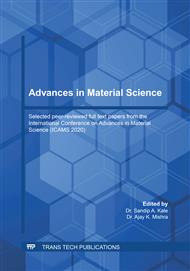[1]
P.T.N Nguyen, T.H Tran, Application of Response Surface Methodology to Optimize The Process of Saponification Reaction from Coconut Oil in Ben Tre - Vietnam, Solid State Phenomena. 279 (2018) 235–239.
DOI: 10.4028/www.scientific.net/ssp.279.235
Google Scholar
[2]
T.H Tran, T.H.T. Tran, H.Q Pham, Production Process of Hand Sanitizer from Vietnamese Coconut Oil, Asian J. Chem. 31 (2019) 1200–1206.
DOI: 10.14233/ajchem.2019.21767
Google Scholar
[3]
A. S. Bhatnagar Æ P. K. Prasanth Kumar, Fatty Acid Composition, Oxidative Stability, and Radical Scavenging Activity of Vegetable Oil Blends with Coconut Oil, J Am Oil Chem Soc. 86, (2009) 991–999.
DOI: 10.1007/s11746-009-1435-y
Google Scholar
[4]
D.C. Creswell, C.C. BrookS, Composition, apparent digestibility and energy evaluation of coconut oil and coconut meal, J Anim Sci. 33 (1971) 366-369.
DOI: 10.2527/jas1971.332366x
Google Scholar
[5]
Lucita R. Laureles, Variability in Fatty Acid and Triacylglycerol Composition of the Oil of Coconut (Cocos nucifera L.) Hybrids and Their Parentals, J Agric Food Chem. 50 (2002), 1581-1586.
DOI: 10.1021/jf010832w
Google Scholar
[6]
S. Intahphuak, P. Khonsung, A. Panthong, Anti-inflammatory, analgesic and antipyretic activities of virgin coconut oil. Pharm Biol.48 (2010) 151-157.
DOI: 10.3109/13880200903062614
Google Scholar
[7]
Bruce Fife, Coconut_Cures, Preventing and Treating Common Health problems with coconut, Piccadilly Books Ltd, USA.
Google Scholar
[8]
N. Satheesh, Review on production and potential applications of virgin coconut oil, Ann Food Sci Technol. 16 (2015) 115-126.
Google Scholar
[9]
K. N. Seneviratne and D. M. S. Dissanayake, Original article Variation of phenolic content in coconut oil extracted by two conventional methods, Int J Food Sci Technol. 43 (2008) 597–602.
DOI: 10.1111/j.1365-2621.2006.01493.x
Google Scholar
[10]
K.G.N.T. Rajamohan, Effect of Topical Application of Virgin Coconut Oil on Skin Components and Antioxidant Status during Dermal Wound Healing in Young Rats, Skin Pharmacol Physiol. 23 (2010) 290–297.
DOI: 10.1159/000313516
Google Scholar
[11]
Z.A. Zakaria, M.N. Somchit, A.M. Mat Jais, K. Long, In vivo Antinociceptive and Antiinflammatory Activities of Dried and Fermented Processed Virgin Coconut Oil, Med Princ Pract. 20 (2011) 231–236.
DOI: 10.1159/000323756
Google Scholar
[12]
S. Intahphuak, P. Khonsung, and A. Panthong, Anti-inflammatory, analgesic, and antipyretic activities of virgin coconut oil, Pharm Biol. 48 (2010) 151-157.
DOI: 10.3109/13880200903062614
Google Scholar
[13]
R. Sodha, S. Gaonkar, S. Kolte, and P. Padmanabha, Antibacterial and Antifungal Activity of Crude Coconut Shell Oil, Int Res J Biol Sci. 4 (2015) 16-20.
Google Scholar
[14]
J. Of, M. Food, and A. A. Oni, In Vitro Antimicrobial Properties of Coconut Oil on Candida Species in Ibadan, Nigeria, J Med Food. 10 (2007) 384–387.
DOI: 10.1089/jmf.2006.1209
Google Scholar
[15]
A.R. Oyi, J.A. Onaolapo, and R.C. Obi, Formulation and Antimicrobial Studies of Coconut (Cocos nucifera Linne) Oil, Res J Appl Sci Eng Technol. 2 (2010) 133–137.
Google Scholar
[16]
K.G. Nevin, T. Rajamohan, Virgin coconut oil supplemented diet increases the antioxidant status in rats, Food Chem. 99( 2006) 260–266.
DOI: 10.1016/j.foodchem.2005.06.056
Google Scholar
[17]
Z. Ahmad, M. Roji, and R. Hasham, Evaluation of Wound Closure Activity of Cocos Nucifera Oil on Scratched Monolayer of Human Dermal Fibroblasts, Chem Eng Trans. 56 (2017) 1657-1662.
Google Scholar
[18]
C. L. Burnett, Final Report on the Safety Assessment of Cocos nucifera (Coconut ) Oil and Related Ingredients, Int J Toxicol. 30 (2011) 5S-16S.
DOI: 10.1177/1091581811400636
Google Scholar
[19]
K.G.N.T. Rajamohan, Effect of Topical Application of Virgin Coconut Oil on Skin Components and Antioxidant Status during Dermal Wound Healing in Young Rats, Skin Pharmacol Physiol. 23 (2010) 290–297.
DOI: 10.1159/000313516
Google Scholar
[20]
A. M. Marina, Y. B. Che man, S. A. H. Nazimah, and I. Amin, Antioxidant capacity and phenolic acids of virgin coconut oil," Int. J. Food Sci. Nutr., 60 (2009) 114–123.
DOI: 10.1080/09637480802549127
Google Scholar
[21]
B. Aggarwal, H. S. Lamba, and P. Sharma, Various Pharmacological Aspects of Cocos nucifera - A Review, Am J Pharmacol Sci. 5 (2017), 25-30.
Google Scholar
[22]
T. Aburjai and F. M. Natsheh, Plants Used in Cosmetics, Phyther Res. 17 (2003) 987–1000.
DOI: 10.1002/ptr.1363
Google Scholar
[23]
A.L.C. Agero, V.M. Verallo-Rowell, A Randomized Double-Blind Controlled Trial Comparing Extra Virgin Coconut Oil with Mineral Oil as a Moisturizer for Mild to Moderate Xerosis, Dermatitis, 15 (2004) 109-116.
DOI: 10.2310/6620.2004.04006
Google Scholar


